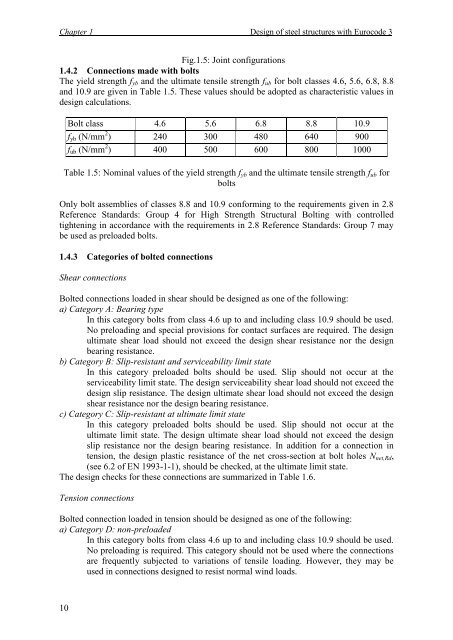Nonlinear Static and Dynamic Analysis of Steel Structures with ...
Nonlinear Static and Dynamic Analysis of Steel Structures with ...
Nonlinear Static and Dynamic Analysis of Steel Structures with ...
Create successful ePaper yourself
Turn your PDF publications into a flip-book with our unique Google optimized e-Paper software.
Chapter 1 Design <strong>of</strong> steel structures <strong>with</strong> Eurocode 3<br />
Fig.1.5: Joint configurations<br />
1.4.2 Connections made <strong>with</strong> bolts<br />
The yield strength fyb <strong>and</strong> the ultimate tensile strength fub for bolt classes 4.6, 5.6, 6.8, 8.8<br />
<strong>and</strong> 10.9 are given in Table 1.5. These values should be adopted as characteristic values in<br />
design calculations.<br />
10<br />
Bolt class 4.6 5.6 6.8 8.8 10.9<br />
fyb (N/mm 2 ) 240 300 480 640 900<br />
fub (N/mm 2 ) 400 500 600 800 1000<br />
Table 1.5: Nominal values <strong>of</strong> the yield strength fyb <strong>and</strong> the ultimate tensile strength fub for<br />
bolts<br />
Only bolt assemblies <strong>of</strong> classes 8.8 <strong>and</strong> 10.9 conforming to the requirements given in 2.8<br />
Reference St<strong>and</strong>ards: Group 4 for High Strength Structural Bolting <strong>with</strong> controlled<br />
tightening in accordance <strong>with</strong> the requirements in 2.8 Reference St<strong>and</strong>ards: Group 7 may<br />
be used as preloaded bolts.<br />
1.4.3 Categories <strong>of</strong> bolted connections<br />
Shear connections<br />
Bolted connections loaded in shear should be designed as one <strong>of</strong> the following:<br />
a) Category A: Bearing type<br />
In this category bolts from class 4.6 up to <strong>and</strong> including class 10.9 should be used.<br />
No preloading <strong>and</strong> special provisions for contact surfaces are required. The design<br />
ultimate shear load should not exceed the design shear resistance nor the design<br />
bearing resistance.<br />
b) Category B: Slip-resistant <strong>and</strong> serviceability limit state<br />
In this category preloaded bolts should be used. Slip should not occur at the<br />
serviceability limit state. The design serviceability shear load should not exceed the<br />
design slip resistance. The design ultimate shear load should not exceed the design<br />
shear resistance nor the design bearing resistance.<br />
c) Category C: Slip-resistant at ultimate limit state<br />
In this category preloaded bolts should be used. Slip should not occur at the<br />
ultimate limit state. The design ultimate shear load should not exceed the design<br />
slip resistance nor the design bearing resistance. In addition for a connection in<br />
tension, the design plastic resistance <strong>of</strong> the net cross-section at bolt holes Nnet,Rd,<br />
(see 6.2 <strong>of</strong> EN 1993-1-1), should be checked, at the ultimate limit state.<br />
The design checks for these connections are summarized in Table 1.6.<br />
Tension connections<br />
Bolted connection loaded in tension should be designed as one <strong>of</strong> the following:<br />
a) Category D: non-preloaded<br />
In this category bolts from class 4.6 up to <strong>and</strong> including class 10.9 should be used.<br />
No preloading is required. This category should not be used where the connections<br />
are frequently subjected to variations <strong>of</strong> tensile loading. However, they may be<br />
used in connections designed to resist normal wind loads.

















